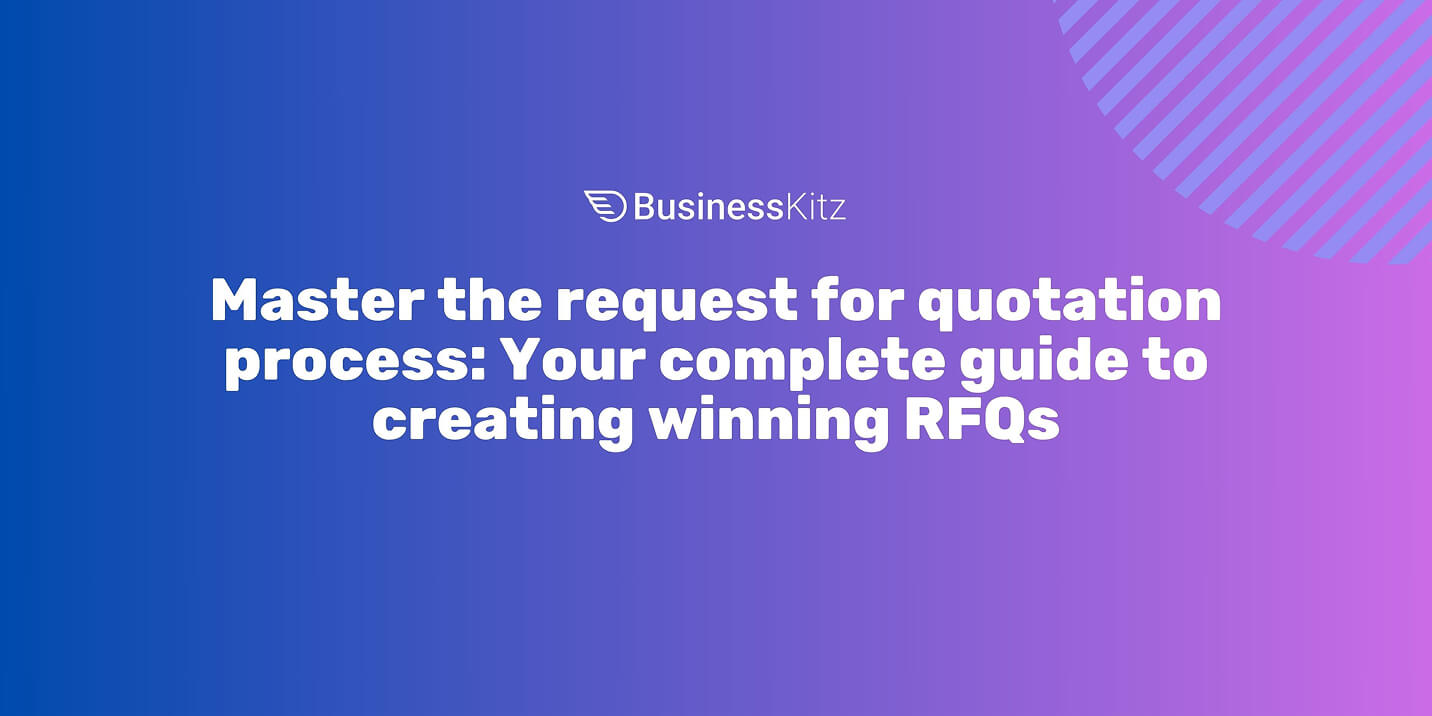
Looking to streamline your procurement process but confused about when to use a request for quotation? You're not alone—many businesses struggle to differentiate between RFQs, RFPs, and RFIs, leading to wasted time and missed opportunities. A well-crafted request for quotation can transform your vendor selection process from a time-consuming headache into a strategic business advantage. Whether you're sourcing office supplies or complex services, understanding the RFQ process is essential for securing the best prices and terms from suppliers. Let's demystify the request for quotation and show you exactly how to create RFQs that get results.
We've helped businesses save $55m with our all-in-one platform. Get instant access to this template and 115+ others, plus AI-powered document creation, starting completely free.
A request for quotation (RFQ) is a formal business document that companies use to invite suppliers to submit detailed pricing for specific products or services. Think of it as your structured way of asking vendors "how much will this cost?" when you already know exactly what you need.
Research shows that RFQs are especially important for businesses needing a consistent supply of standard products with specific quantities. Unlike its cousins—the request for proposal (RFP) and request for information (RFI)—an RFQ focuses primarily on pricing and delivery terms rather than creative solutions or general capabilities.
The beauty of an RFQ lies in its specificity. You're not asking vendors to propose solutions or share general information about their services. Instead, you're providing exact specifications and quantities, requesting firm pricing that allows for direct comparison between suppliers.
For businesses managing regular procurement needs—from manufacturing components to professional services—RFQs create a level playing field where vendors compete primarily on price, quality, and delivery terms. This standardised approach saves time for both buyers and sellers by eliminating guesswork and ensuring everyone's quoting on exactly the same requirements.
Navigating the alphabet soup of procurement documents can be overwhelming, but understanding when to use each type is crucial for efficient vendor selection. Let's break down these three essential procurement tools:
An RFI is your research tool—the starting point when you're exploring the market. According to procurement experts, you use an RFI when you know you have a problem but aren't sure who can solve it. It's about gathering general information about vendor capabilities without discussing specific pricing.
RFPs come into play when you need creative solutions. While RFQs compare pricing, RFPs compare total value, especially for complex projects requiring different approaches. You know what outcome you want, but need vendors to propose how they'll achieve it.
RFQs are your go-to when you know exactly what you need and want to compare prices. You've already determined specifications, quantities, and requirements—now you need competitive pricing to make an informed decision.
Here's a simple way to remember:
Understanding these distinctions ensures you're using the right tool for your procurement needs, saving time and getting better results from vendors.

A well-crafted RFQ should include specific details that ensure clarity and promote accurate vendor responses. Here's what every professional RFQ must contain:
Start with complete details about your organisation and the project at hand. Include your company name, contact person, and project background. This context helps vendors understand your needs and tailor their responses appropriately.
Be specific about requirements—tell vendors the exact products or services needed, including quantities, quality standards, and technical specifications. The more precise your specifications, the more accurate and comparable the quotes you'll receive.
Clearly outline how vendors should format and submit their quotations. Specify whether you want itemised pricing, bulk discounts, or alternative pricing structures. Include the submission deadline and preferred delivery method.
Include your standard terms covering payment schedules, delivery requirements, warranties, and any compliance requirements. This transparency helps vendors factor all considerations into their pricing.
Let vendors know how you'll assess their submissions. While price is typically the primary factor in RFQs, you might also consider delivery times, payment terms, or quality certifications.
Provide a clear schedule including the RFQ submission deadline, expected decision date, and project start date. Allowing a few weeks for vendor responses helps ensure quality submissions.
Remember, a well-structured RFQ makes it easier for vendors to provide accurate quotes and simplifies your comparison process.

Creating and managing an effective RFQ doesn't have to be complicated. Follow this proven process to get the best results from your vendor solicitations:
Before drafting your RFQ, gather all stakeholders to clearly define what you need. The preparation phase is the most time-consuming but equally important—the more detail you provide, the more accurate vendor responses will be. Document specifications, quantities, quality standards, and delivery requirements.
Decide whether you'll run an open bid (anyone can participate) or a closed bid (invited vendors only). For most RFQs, it's best to select no more than eight vendors to ensure a manageable evaluation process while maintaining healthy competition.
Using a standardised template ensures consistency and makes vendor comparison easier. Include all essential components we've discussed, and consider using Business Kitz's document management system to maintain version control as you refine your RFQ.
Send your RFQ to selected vendors with clear submission instructions. Maintain fairness by sharing any clarifications or additional information with all participants. Set up a system to track responses—this is where digital document management really shines.
Once the deadline passes, review all submissions against your evaluation criteria. Create a comparison matrix to assess pricing, terms, and other factors side by side.
Choose your vendor based on your evaluation criteria and notify all participants of your decision. Even unsuccessful vendors appreciate feedback, and maintaining good relationships benefits future procurement needs.
Even experienced procurement professionals can fall into these traps. Here's how to sidestep the most common RFQ pitfalls:
The biggest mistake? Being unclear about your requirements. Generic descriptions like "office supplies" or "marketing services" result in wildly different quotes that you can't meaningfully compare. Instead, specify exact products, quantities, and service levels.
Rushing vendors with tight deadlines often results in higher prices or incomplete responses. Allow at least two weeks for complex RFQs to ensure vendors can provide thoughtful, accurate quotations.
Don't focus solely on unit prices. Consider delivery costs, payment terms, minimum order quantities, and potential volume discounts. The lowest price isn't always the best value.
Failing to document and share clarification questions with all vendors creates an unfair advantage. Use a centralised system to track all communications and ensure transparency.
Without predetermined criteria, vendor selection becomes subjective and difficult to justify. Define your evaluation framework before sending the RFQ.
Sending RFQs to unqualified vendors wastes everyone's time. Pre-qualify suppliers to ensure they can meet your requirements before including them in your RFQ process.
By avoiding these common mistakes, you'll receive more accurate quotes and make better procurement decisions.
Transform your RFQ process from good to exceptional by implementing these proven best practices:
Create reusable templates for different types of purchases. This consistency not only saves time but also helps vendors understand your requirements more quickly. Business Kitz's template library provides professional RFQ templates you can customise for your specific needs.
While detailed specifications are crucial, avoid being so prescriptive that you eliminate innovative solutions. Provide enough flexibility for vendors to suggest alternatives that might better meet your needs.
Consider market conditions and vendor busy seasons when issuing RFQs. Avoiding peak periods often results in more competitive pricing and better response rates.
Maintain records of past RFQ participants, their performance, and pricing history. This institutional knowledge streamlines future procurement and helps identify reliable suppliers.
Digital tools can revolutionise your RFQ process. From automated distribution to digital signatures on awarded contracts, technology reduces errors and speeds up the entire cycle.
The optimal time to follow up is 2-3 days after sending your RFQ. This gentle reminder keeps your request top-of-mind without appearing pushy.
Maintain clear records of all RFQs, responses, and decisions. This audit trail proves invaluable for future reference and ensures compliance with procurement policies.

Manual RFQ processes drain valuable time and resources from your business. Studies show teams take 73% more time creating quotes without proper tools, often losing deals to faster competitors. Here's how digital transformation changes the game:
Stop searching through emails and folders for RFQ documents. A centralised system keeps all your procurement documents organised and accessible, making it easy to reference past RFQs and track current ones.
When RFQs require revisions, version control ensures everyone works with the latest document. No more confusion about which version vendors should respond to or which changes were approved.
Share RFQs with internal stakeholders for input without the back-and-forth of email chains. Real-time collaboration tools let multiple team members contribute to RFQ development simultaneously.
Set up approval workflows that route RFQs through necessary checkpoints before distribution. This automation prevents costly mistakes and ensures compliance with procurement policies.
Once you've selected a vendor, digital signing capabilities mean contracts can be executed in hours instead of days. This speed gives you a competitive advantage in securing the best suppliers.
Track which RFQs generate the best responses and identify patterns in successful procurement. These insights help refine your process over time.
Business Kitz's comprehensive document management platform brings all these capabilities together, transforming how SMEs handle their RFQ processes.
The complete RFQ process typically takes 4-8 weeks from initial preparation to contract signing. This includes 1-2 weeks for RFQ preparation, 2 weeks for vendor responses, and 1-2 weeks for evaluation and selection. However, simpler purchases might be completed faster, while complex procurements may take longer.
Best practice suggests inviting no more than eight vendors for most RFQs. This number provides sufficient competition while keeping the evaluation process manageable. For simple, commodity purchases, 3-5 vendors might suffice, while complex purchases might warrant the full eight.
RFQs work well for both standardised services and products. Use them when service requirements are clearly defined—like cleaning services, routine maintenance, or standard professional services. However, for creative or consultative services where approach matters more than price, an RFP is usually more appropriate.
An open RFQ allows any qualified vendor to submit a quote, often posted publicly or on procurement portals. A closed RFQ invites only pre-selected vendors to participate. Closed RFQs typically generate more tailored responses but might miss competitive newcomers to the market.
Most organisations set RFQ validity between 30-60 days. This timeframe balances giving vendors certainty about their pricing while protecting them from market fluctuations. Shorter periods might rush decisions, while longer ones risk pricing changes.
Yes, RFQ responses often serve as the starting point for negotiations. While the RFQ process emphasises transparent comparison, it's common to negotiate better terms, volume discounts, or payment conditions with your preferred vendors before finalising contracts.
If responses don't meet your needs, you have several options: revise your specifications and reissue the RFQ, switch to an RFP to allow for creative solutions, or engage directly with vendors to understand why requirements couldn't be met. Sometimes, unrealistic specifications or budgets need adjustment.
You've learned that creating effective RFQs doesn't have to be a complex, time-consuming process that bogs down your procurement activities. With the right approach, clear specifications, and proper tools, you can transform vendor selection from a necessary evil into a strategic advantage for your business. Remember—the key to RFQ success lies in preparation, clarity, and systematic evaluation of responses. Ready to revolutionise how you handle requests for quotation and take your procurement process to the next level?
Sign up for free and discover how Business Kitz's document management platform and professional RFQ templates can streamline your entire procurement process today.
Copyright © 2025 Business Kitz 14312161